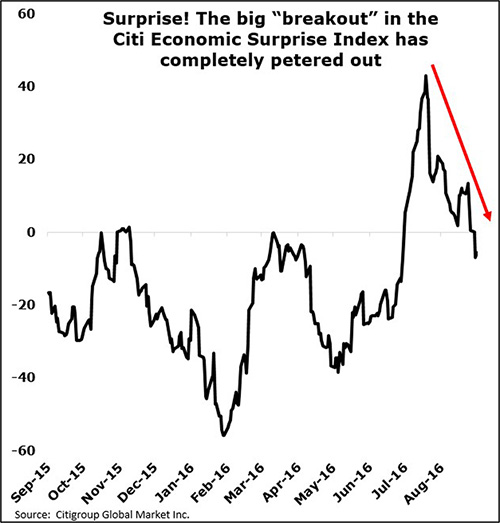Energy & Commodities
 Oilfield services, shipbuilders and other industries that rose with the pre-2014 oil price boom have had it hard. Since barrel rates fell, their previous patrons have become uninterested in doling out major purchase orders, leaving oil and gas equipment manufacturers without revenues.
Oilfield services, shipbuilders and other industries that rose with the pre-2014 oil price boom have had it hard. Since barrel rates fell, their previous patrons have become uninterested in doling out major purchase orders, leaving oil and gas equipment manufacturers without revenues.
A recent report by Arkansas Online says the energy industry’s support sector could feel the effects of low oil prices for up to two years after the current bear market recovers.
“When oil gets good again we will be the last to get back to work” because half the fleet available is not currently in use, Vance Breaux Jr., a boat manufacturer from Louisiana, said.
Louisiana’s rig count has shrunk to 35 active sites as of last week – down 40 from the same time last year, according to Baker Hughes latest report on the matter.
Currently, Breaux and his industry compatriots lack diversification in their client profile. Production sites with easy-to-reach oil and gas deposits are running out in Louisiana, but the weak investment climate prevents energy firms from starting new projects, making it difficult for equipment manufacturers to generate revenues.
In other parts of the country, bargain hunters are snagging expensive oil and gas equipment at auctions for a fraction of their original cost.
“Everyone says we’re crazy, but we’re hoping to capitalize on the downstroke,” Shawn Kluver, a buyer in the market for a hydro excavator truck, told USA Today last year.
Kluver flew to Colorado from North Dakota to compete with more than 3,000 bidders for a rock-bottom price on backhoes, bulldozers, trucks and other heavy equipment.
As hundreds of oil and gas rigs shut down across the United States, falling bottom lines force oil and gas majors to abandon future exploration projects and reduce the scope of ongoing ventures, causing thousands of drilling workers to lose their jobs and the equipment they once used to sit idle.
If a company begins liquidating its assets, some of the idle equipment may find itself in the hands of industry resellers, such as the Vancouver-based Ritchie Bros, which claims to be the world’s largest auctioneer of heavy equipment.
The company says it has seen a peak interest in its events this year, driven in large part by contractors looking to repurpose drilling equipment for construction projects.
Oil and gas firms have been hemorrhaging workers and physical assets essential to drilling operations, which means bringing oil and gas companies back into peak production will not happen overnight when prices do recover.
In June, The Wall Street Journal, used data from HIS Energy to estimate that roughly 70 percent of the fracking equipment across the shale industry had been idled due to financial constraints. Also, about 60 percent of U.S. field workers needed to frack shale wells have been handed pink slips since the pricing crisis began two years ago. Many of those workers have moved on to jobs in other industries over the past two years, clearing the job market of experienced hires.
“It’s scary to think what a drag and what a headwind finding experienced labor is going to be this time around,” Roe Patterson, CEO of Basic Energy Services, a Texas-based well completion company, told the WSJ.
Patterson also emphasized that the state of equipment deteriorates due to wear and tear over time, even when its not in use.
“Pop the hood on your car and let it sit for a year,” he suggested. “I guarantee the car won’t be in the same condition.”
As Hordes of heavy drilling equipment exit the energy industry to be repurposed, the woes of oil and gas equipment manufacturers will continue as the industry finds its footing in a recovered market. Once profits from existing drilling projects begin to show in oil and gas companies’ books, new sites will be brought into production, spurring further equipment purchases.
Though the energy equipment industry may see a delayed boom as idled equipment stored in warehouses slowly returns to duty, firms will have to turn to their old sources to replace their now-sold assets. Better late than never.
By Zainab Calcuttawala for Oilprice.com

Do me a favor and punch up a chart of General Electric (GE). Or 3M (MMM). Or DuPont (DD). Or United Parcel Service (UPS). Or basically any major blue chip, widely held, large capitalization stock.
What do you see over the past few weeks? Nothing. Very little net movement. Extremely tight ranges. Some of the smallest daily candles and bars you will EVER see on a stock chart.
It’s not just your imagination, either. The markets are truly somnolent, even now with the traditional pre-Labor Day quiet period over.
 I read one fascinating article earlier this week that concluded the Dow Jones Industrial Average hasn’t traded in this narrow of a high-to-low, 40-day range in the last 100 years. Another analyst found the S&P 500 hasn’t been this tightly coiled since 1928.
I read one fascinating article earlier this week that concluded the Dow Jones Industrial Average hasn’t traded in this narrow of a high-to-low, 40-day range in the last 100 years. Another analyst found the S&P 500 hasn’t been this tightly coiled since 1928.
What the heck is going on? And what does all this low volatility mean for you as an investor?
Well, some of the blame lies with “volatility selling” in the options market, as I wrote about last month. It’s another way of squeezing a few nickels of income out of the markets in a NIRP/ZIRP world, and everyone is doing it these days.
Some of it also stems from investors anticipating potential market-moving events. The Federal Reserve and Bank of Japan are meeting on policy later this month, and investors are hesitant to make big moves ahead of those events.
Finally, some of it stems from confusion about where the economy is headed. We had a lousy start to the year, followed by a bounce back in June and July.
Now the question is whether that economic bounce is petering out.
The August jobs figures and other reports on the manufacturing and services sector suggest that is the case. So does the Citi Economic Surprise Index.
The gauge purports to show whether the majority of economic reports are beating or missing economist forecasts. Many bulls crowed about how it “broke out” back in July. But take a look at this chart. The entire breakout has petered out …

I have my suspicions about where things will likely break from here.
The widening disconnect between economic reality and stock prices isn’t very encouraging, and is likely to be resolved by a downside break. Conservative “safety plays” should outperform risky, economically sensitive names. In a pre-recessionary environment, the dollar is also likely to lose, while gold and Treasuries should be winners.
But it makes sense not to get too aggressive until the market actually tips its hand. In your personal investing, I would play things smaller in terms of capital committed until we get a breakout in these various asset classes.
Until next time,
Mike Larson


The three major themes or drivers of this current bull market and why the current run isn’t likely to end for still another 3 years or more. Remarkably the nations public pension funds have grown to the point they dwarf the Federal Reserve. In order to prevent shortfalls, federal, state and municipalities have raise taxes, and that money has to go somewhere.
Brian Reynolds is the Chief Market Strategist for New Albion Partners. Brian specializes in relating developments in the credit and related markets to the equity market.
For full access to the interview, please log in and click the MP3 button or click here to subscribe. Questions? Check out our FAQ page.


In response to the dire state of Italy’s largest banks, the question is “What are the top 5 biggest and safest banks in the world?”
Here are the global banks with assets of $4 billion or more that earn our highest Weiss Safety Ratings:

Or, if you prefer banks that are even larger ($200 billion or more in assets), our Weiss Safety Ratings are a tad lower, but still in the “excellent” category:

Want to restrict your banking to U.S. institutions? No problem. We have recently released our Weiss Safety Ratings for the highest-rated largest banks in the U.S. based on their financial data of June 30, 2016:

….to read the entire article go HERE



 Events are moving behind the scenes. For decades, Western Central bankers have told the masses that gold is a barbarous relic. They have encouraged us to shed its protection and move into the sanctity of their highly corrupt and highly manipulated fiat assets.
Events are moving behind the scenes. For decades, Western Central bankers have told the masses that gold is a barbarous relic. They have encouraged us to shed its protection and move into the sanctity of their highly corrupt and highly manipulated fiat assets.









